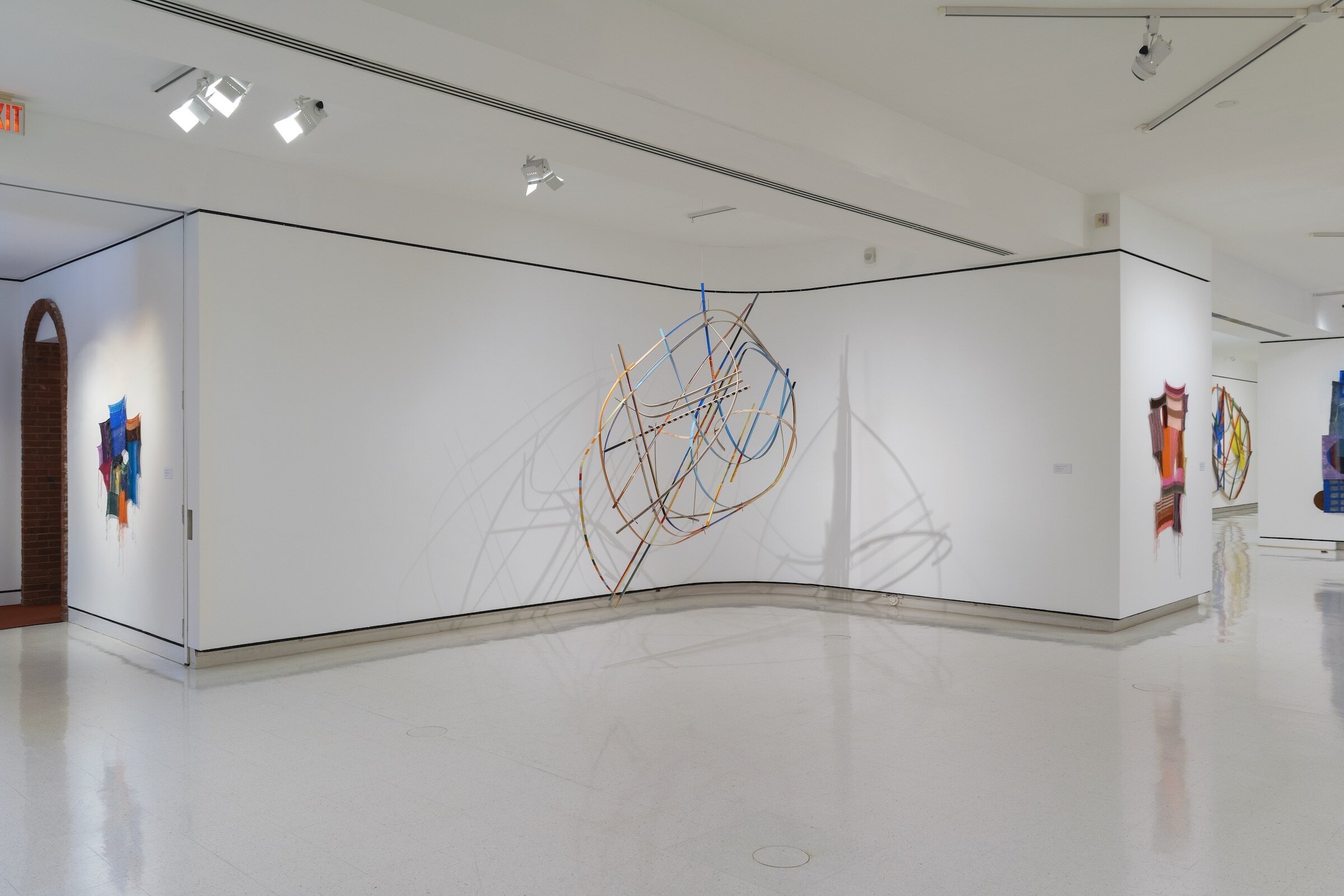Take Five at UB Anderson Gallery
by :
Brooke Leboeuf
Take Five, 2019. Installation photos: Nick Ostness.
The five contemporary artists in Take Five at UB Art Galleries—Meghan Brady, Adriane Colburn, Melissa Dadourian, Tricia Keightley, and Meg Lipke—carry on and further the tradition of postwar American abstraction. Their work comes long after the revolutionary Abstract Expressionist movement of the 1940s and 50s, which emerged from the traumas of two world wars and the Great Depression to change the trajectory of art history. Along the way, Abstract Expressionism became synonymous with the macho personas of its male practitioners, artists like Willem de Kooning, Jackson Pollock, and Mark Rothko. The women creating revolutionary works right alongside their male counterparts were largely written out of the narrative of the movement in its time and since. As a group exhibition of contemporary female abstractionists, Take Five complements a recently emergent universe of exhibitions, articles, and catalogues reexamining the origins of Abstract Expressionism to highlight the contributions of women artists once overlooked or marginalized.
Meghan Brady paints expansive works on paper, combining large swaths of supersaturated color with various intersecting shapes and lines in inviting, floor-to-ceiling installations. Everyday (2018) is unconfined by any type of frame; its overlapping canvases jut out in different directions, taking on an irregular shape. It is full of playfulness, possibility, and an exuberant lack of restraint.
Tricia Keightley is the only artist in the show working on traditional stretched canvases. The precise lines and forms that together make up what appear to be mechanical schematics are, amazingly, entirely improvisational. However, following the complex arrangement of levers arrayed on a crimson field in 68.68.15 (2015) only leads you to the realization that these couldn’t actually work. The painting has a machine-like precision but describes an abstracted, nonfunctional object, making apparent the beauty and futility of modern technology.
Take Five, 2019. Installation photos: Nick Ostness.
Adriane Colburn’s work is made up of long, thin strips of wood bent and shaped into graceful, curved lines. The wooden curvilinear forms of Gyre Transit (2019) intertwine with one another to resemble maps or the inner workings of machines. The intersections that occur in Colburn’s work are a reflection of the complex relationships between the natural world’s underlying systems and our own technological advances–the curved wood is ash, a species notable for its recent decimation by the Ash Borer beetle, which travels on board container ships from China in wooden pallets, a material also reclaimed and painted to produce these works.
Meg Lipke’s enormous, plush, organic-looking forms, specifically Garden Gates I (2019) and Pink Chalk (2016), seem to take their cue equally from the audacious sculptures of Claes Oldenburg and the gossamer stained canvases of Helen Frankenthaler. Made of fabric ranging from muslin to old coats once worn by the artist’s mother, there is a softness and an agedness to them. They appear as an elder might, bent from time and weighed down by experience but not broken, held up by spirit and accrued wisdom, still vibrating with life—here expressed in Lipke’s vibrant staining. They dominate, they bend, they droop, and they call as much attention to their surrounding negative space as to themselves. These sage organic forms act as keepers of time and space.
Melissa Dadourian’s beautifully colored, tactile grids of sewn fabric and thread are the antithesis of the hard-edged, repetitive forms of pioneering modernists like Mondrian or the Buffalo-native Ad Reinhardt. As in Lipke’s sculptures, strings and imperfections are not only visible but intentional, showing the artist’s hand in the work. Dadourian’s grids, like those in Soft Weirdo Composition (2019), for example, veer off course, teetering and stretching, literally breaking the modernist mold with every last fiber of their being.
The beauty of this show does not reside just in the individual works of the artists, although they each hold a commanding presence all their own, but in the way the works speak to each other: Lipke’s bent forms are reflected in Colburn’s curved wood, and Dadourian’s handcrafted grids in checkered passages of Brady’s roughly painted works. They are astutely placed, so that an exchange can be felt, a conversation that is as lyrical as it is thought-provoking, one that upholds the individuality of each artist while simultaneously creating an energized unity.
Take Five, 2019. Installation photos: Nick Ostness.
Brooke Leboeuf is an arts writer, private art collection consultant, and an ardent supporter of Buffalo’s thriving arts scene.
Take Five, UB Anderson Gallery
1 Martha Jackson Pl, Buffalo, NY 14214




